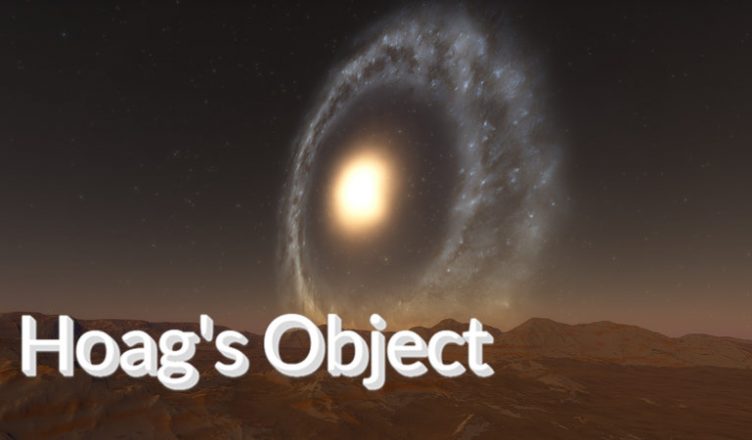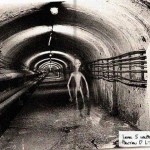Hoag’s Object is an atypical galaxy often referred to as a ring galaxy due to its highly distinctive shape. This galaxy features a central yellow core structure surrounded by a distant ring-like structure. Hoag’s Object contains approximately 8 billion stars and has a diameter of approximately 120,000 light-years. Located at a distance of approximately 600 million light-years from us, Hoag’s Object has a yellow core with a diameter of about 17,000 light-years, while the inner and outer diameters of the surrounding circular ring measure 80,000 and 120,000 light-years, respectively. In comparison, our Milky Way galaxy has a diameter of approximately 150,000 to 200,000 light-years and consists of around 500 billion stars with a mass ranging from 8,000 to 15.4 trillion times that of the Sun. The origin of Hoag’s Object has always been a mystery, and below are the five major enigmas surrounding Hoag’s Object:
1. Mysterious Hoag’s Object: The Cosmic Enigma in the Serpent Constellation
In the northern skies, within the Serpent constellation, lies a peculiar celestial entity known as Hoag’s Object. Since its discovery by astronomer Arthur Hoag in 1950, the origin of its unusual morphology has remained a mystery to this day.
Recently, images captured by the Hubble Space Telescope and processed by geophysicist Benoit Blanco have revealed a nearly perfect circular formation composed of blue stars (relatively young, massive stars) encircling a spherical core made up of a multitude of red stars (somewhat older stars). In the dark expanse of space, one can also spot another distant red ring-shaped galaxy within the gaps between them.
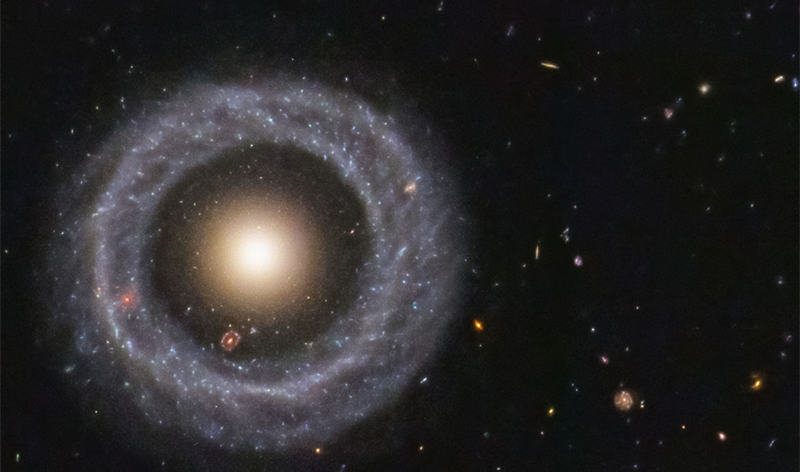
Hoag’s Object boasts a diameter of approximately 100,000 light-years, slightly larger than that of the Milky Way, and it is situated at a distance of 600 million light-years from Earth. Hoag himself initially speculated whether the circular ring might be a gravitational lensing-induced illusion. However, subsequent observations through telescopes quickly dispelled this notion, confirming the object’s true form.
2. The Mysterious Eye: Unraveling the Enigma of Hoag’s Object
In July 2001, the Hubble Space Telescope captured an exceptionally unique image of a galaxy unlike the countless others in the vast cosmic sea. This galaxy, known as Hoag’s Object, is characterized by a nearly perfect circular arrangement of hot, young, blue stars encircling a central yellow nucleus, creating the striking resemblance of a colossal eye in the dark expanse of the universe. This beautiful yet enigmatic celestial entity, Hoag’s Object, resides at a distance of 600 million light-years from Earth. Astronomers estimate its diameter to be approximately 100,000 light-years, comprising around 8 billion stars and possessing a mass of roughly 700 billion solar masses.
In comparison to the Milky Way, which ranges from 800 billion to 1.54 trillion solar masses, Hoag’s Object may seem like a “small fry.” However, it belongs to an atypical galaxy category known as a ring galaxy. The outer regions of this ring galaxy host massive, young, and extremely luminous blue stars, collectively forming a flawless circular structure. Nevertheless, the central region of the circular ring is surprisingly void of matter, with the exception of an older central core. This peculiar feature leaves a substantial gap between the ring and the core, further adding to the mystery surrounding this extraordinary celestial object.
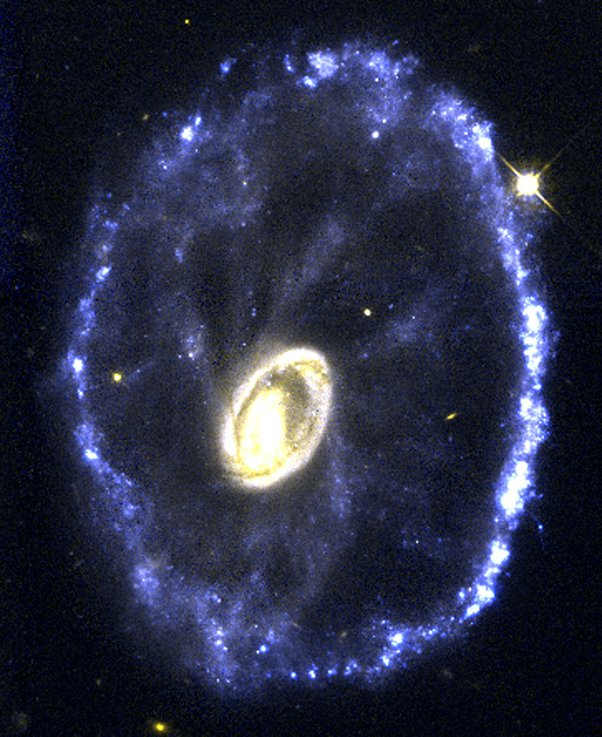
3. Hoag’s Object: The Mystery of a Ring Galaxy in the Universe
Hoag’s Object is a rare ring-shaped galaxy, measuring approximately 100,000 light-years in diameter (slightly larger than the Milky Way’s orbit), and situated approximately 600 million light-years away from Earth. The Hubble Space Telescope continues to make new discoveries in this regard. This photograph was taken by the telescope and processed by geophysicist Bennet Branko.
In the image, we can observe billions of sparkling blue stars forming a perfect ring that encircles a smaller, denser galaxy composed of yellow stars, which are older in age. Between these two ring-shaped galaxies, we can observe another ring-shaped galaxy that is even farther away.
Astronomers remain uncertain about what caused the galaxy to split into two distinct parts. To protect these galaxies, it is crucial to understand that ring galaxies make up less than 0.1% of all known galaxies, making them one of the most challenging types of galaxies to study. At first, Arthur Hoag himself suggested that the unique rings formed within the galaxy were optical illusions caused by gravitational lensing, implying that the ring was a distant image distorted by yellow stars. However, later astronomers used more advanced telescopes to conduct further research and refute this theory.
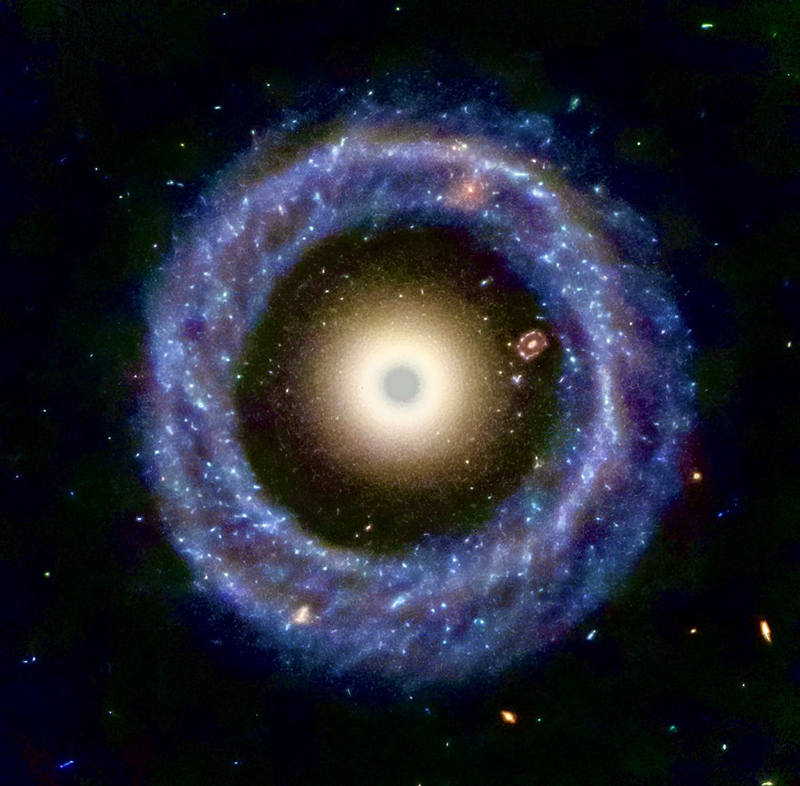
4. The Enigma of Hoag’s Object: Unveiling the Unsolved Mysteries of the Universe
In 1950, when astronomer Arthur Hoag first discovered Hoag’s Object, he didn’t initially perceive it as a galaxy. Initially, Arthur believed that the ring he observed was a product of gravitational lensing, a phenomenon where light bends in the presence of gravitational fields.
However, as Arthur continued his observations, he realized that he had oversimplified things. The central yellow nucleus and the surrounding ring had the same redshift, indicating that the ring was not a mere gravitational lensing effect but rather a coexisting part of the galaxy with the nucleus.
In addition to the redshift, when other astronomers used more advanced space telescopes to study Hoag’s Object, they clearly observed intricate structures in the outer ring. If the ring were solely a result of gravitational lensing, it would not possess these complex features.
Understanding the appearance of Hoag’s Object has, paradoxically, shrouded astronomers’ research in a layer of mystery. Since it’s not a visual illusion, the question remains: how exactly are the ring and the nucleus combined?
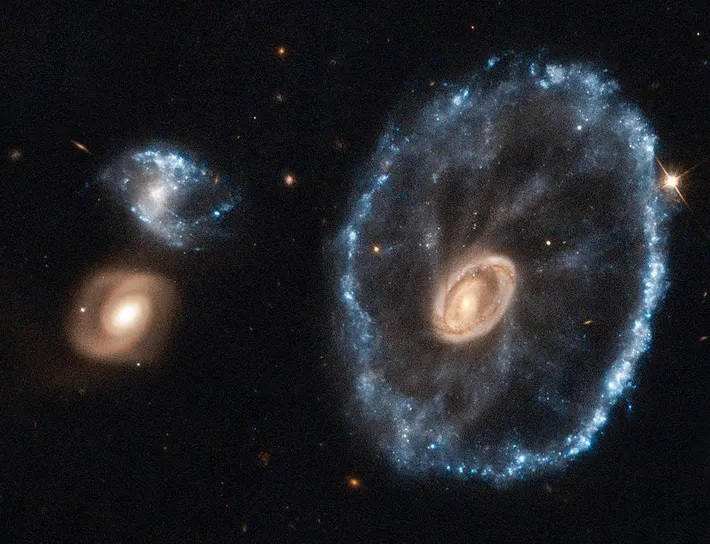
5. The Mystery of Hoag’s Object: Galaxy Collisions and Formation in the Universe
Let’s first take a look at a classic ring galaxy, R5519. This galaxy stands out as the most dazzling among 4,000 galaxies in data from the Hubble Space Telescope and the W.M. Keck Observatory in Hawaii. It also exhibits typical characteristics of a ring galaxy. Astronomers have carefully analyzed its structure and the surrounding celestial objects, suggesting that R5519’s form may have resulted from a galaxy collision. About 40 million years ago, R5519 collided head-on with its companion galaxy, G5593, causing a wave of stars to expand outward from the center.
So, did Hoag’s Object also appear due to a cosmic “car crash”? Astronomers turned to the most sensitive telescopes in the hopes of discovering faint fragments or remnants of a collision surrounding Hoag’s Object. Unfortunately, they found nothing. There is no evidence indicating that another galaxy acted as a “bullet,” piercing through Hoag’s Object. Furthermore, Hoag’s Object’s core is too old, and its velocity compared to the ring is strangely low, which contradicts the classic theory of ring galaxy formation. Since it didn’t result from a collision, Hoag’s Object couldn’t have simply materialized out of thin air. Another astronomer, Noah Brou, proposed an alternative hypothesis, suggesting that Hoag’s Object might have originated from the “bar instability” of a barred spiral galaxy billions of years ago.
However, this hypothesis was swiftly debunked by other astronomers because Hoag’s Object’s core is spherical, while the cores of barred spiral galaxies are disk-like. While these hypotheses have been discarded, scientists acknowledge that they still lack critical evidence to solve this mystery. As for the gaps between the outer ring and the nucleus, researchers can only speculate that these spaces may contain extremely faint and nearly invisible star clusters.
END:
The photo of Hoag’s Object is undoubtedly breathtaking, and its beauty stems from its mysterious and rare galactic structure. For the general audience, this image could serve as an excellent wallpaper choice, but for astronomers, their greater desire lies in unveiling the reasons behind this beauty. It is this spirit of exploring the unknown and unraveling the mysteries of the universe that drives scientists to delve deeper into research, aiming for a more comprehensive understanding of Hoag’s Object and the enigmas of the cosmos. This galaxy will continue to captivate the attention of astronomers, and we look forward to future studies unraveling its mysteries, bringing forth more scientific discoveries and surprises.
More UFOs and mysterious files, please check out our YouTube channel: MysFiles
Is the moon artificial? Evidence Proves the Moon Was Unnaturally Formed
